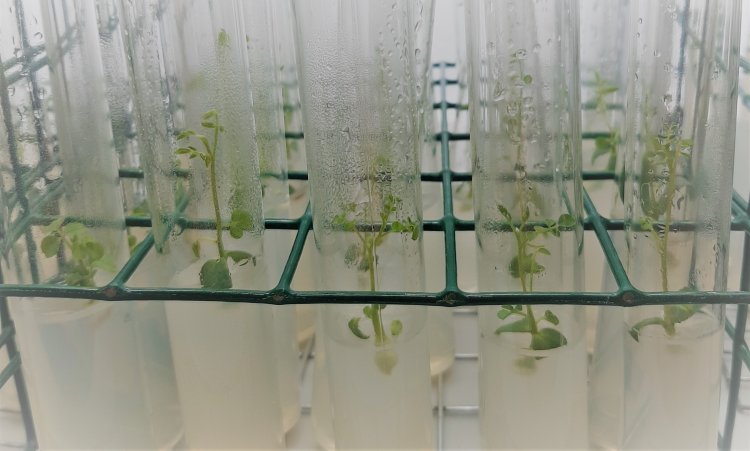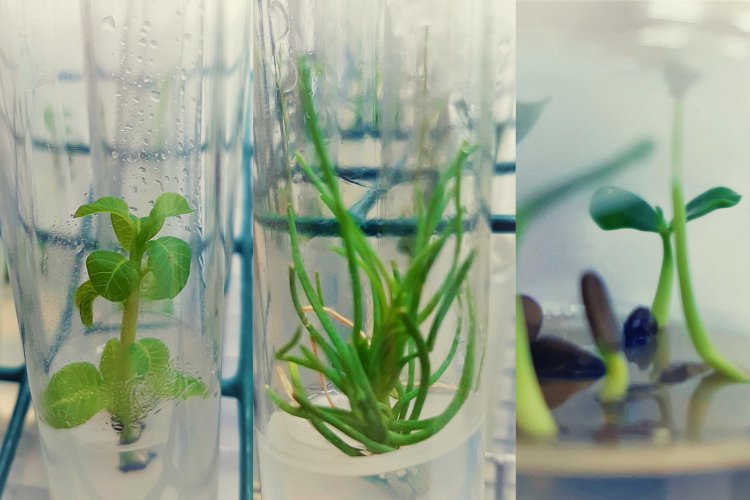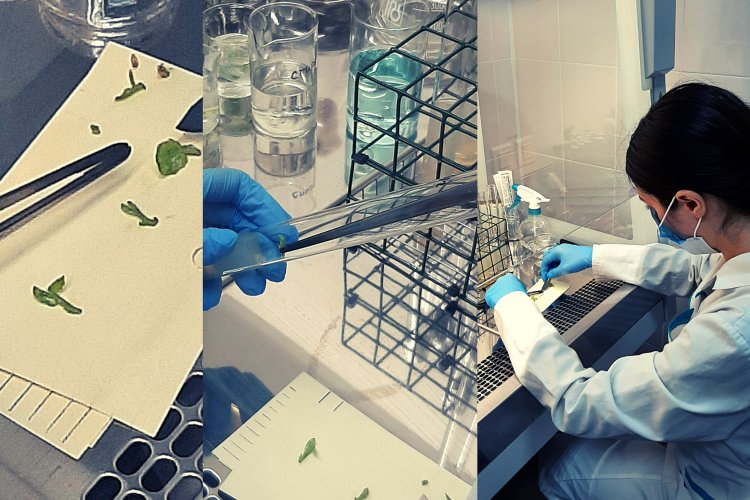Biologists from the Volgograd-based Federal Scientific Center for Agroecology of the Russian Academy of Sciences are carrying out molecular genetic research and development of effective laboratory-scale methods for clonal micropropagation of valuable plant genotypes. These analytical studies are driven by the need to preserve the biodiversity of species in biosystems in view of their geographical and local population variability
Environmental and climate changes, the anthropogenic factor, grazing in protected nature reserves cause the decline in the number of valuable, rare and endangered plant species, increasing the risk of extinction and hindering the sustenance of their populations. In such a case, the biotechnological and molecular genetic aspects of the conservation of a rare plant species play an important role: scientists create genetic banks of rare and valuable plant species to study their features and investigate the options for their in vitro cultivation (growing in a test tube).
Experts from the Center for Agroecology (Volgograd) are researching the problem of biodiversity conservation and developing methods for establishing artificial populations of valuable tree and shrub plants, including variety collections garnered in laboratory conditions. For instance, researchers from the newly-established Youth Labs have applied the clonal micropropagation technique for an in vitro culture and plan to reproduce valuable wood-and-shrub species.
Olga Olegovna Zholobova, Cand. Bio. Sci., Head of Laboratory, Leading Researcher of the Biotechnology Lab of the RAS Center for Agroecology (Volgograd) told us about the motivation for studying plant genetic banks, genetic monitoring techniques used for rare and poorly studied species, the creation of a representative in vitro collection, and an ongoing study based on the method of clonal micropropagation she is heading now in the new Youth Biotech Lab.
The development of molecular genetics techniques together with work on the establishment of plant genetic banks contribute to the conservation of the genetic diversity of rare and endangered plant species.
As noted by Olga Zholobova, “as far as the conservation of biodiversity is concerned, the main objective of research institutions is to comprehensively study and preserve valuable genetic resources of the natural flora by replenishing and maintaining collections of living plants (ex situ, i.e., in nature, in natural places of growth), as well as to develop effective methods of in situ conservation (by cultivating, establishing special arboretums and genetic banks for material storage). Genetic banks are subdivided into several types: field genetic banks (most often established by clone planting of fruit-bearing and forest species, root and tuber crops), seed genetic banks, banks of in vitro cultivated plant material (plant tissues and cells cultivated in slow growth conditions).”
To facilitate genetic monitoring of rare and poorly studied species, a Volgograd specialist, while performing thesis-related research, has devised RAPD and AFLP methods of multilocus analysis.
“When it comes to the effective conservation of a species, one must understand the extent of its genetic diversity in nature.
One of the most rational approaches to describing intra-species diversity is the use of molecular genetic markers that make it easy to identify individual genotypes and estimate the extent of genetic polymorphism within individual populations and within species as a whole. Given that most rare plant species are little studied genetically, they can be evaluated using markers common to all plant and animal species: RAPD and AFLP, ISSR some others,” explained the scientist.
Olga Zholobova had used these methods earlier to monitor the population of Matthiola fragrans. The researcher explained the practical application of these methods and the features they help identify:
“The first step in work involving molecular methods is to obtain isolated genomic DNA from plant tissue. In order to perform RAPD analysis (requiring no knowledge of the DNA sequence, random amplification of a polymorphic DNA) of the Matthiola fragrans genome, eleven 10-term primers have been used that had been previously successfully applied for marking the genome of nightshades, cereals and members of the Stachys, Siringa and other genera. A total of 40 DNA samples representing six populations of M. fragrans were analyzed. Populations studied varied in terms of the level of polymorphism detected. With AFLP (amplified fragment length polymorphism) analysis, differences between populations and the intrapopulation polymorphism of M. fragrans have been additionally identified. AFLP analysis also revealed DNA fragments unique to each population. 22 monomorphic fragments were detected in RAPD spectra and 28 fragments were detected in AFLP spectra. A number of common fragments can be arguably considered as markers of the species.
A good agreement between the results obtained using two different methods suggests that both are valid individually. At the same time, thanks to a simpler analysis technique and more unique fragments detectable in every population compared to AFLP analysis, together with good population separation in statistical processing suggest that RAPD is a better choice (despite the fact that this method has recently been considered “obsolete” by many researchers) for genetic monitoring of M. fragrans populations. On the other hand, a combination of RAPD and AFLP methods would enable more accurate assessment of the genetic diversity and genetic features of populations because it characterizes the wider regions of the genome of the plant under study.”
As emphasized by Olga Zholobova, “the work carried out so far has provided an opportunity to bring the research of rare and endangered plant species to a totally new level. Findings point to a substantial genetic differentiation within the same species exhibiting DNA markers which in turn enable full-scale genetic monitoring. Based on the data obtained, it is clear that in developing a strategy for the conservation of rare species ex situ, it is advisable to determine sampling technique and sample sizes based on data on the level and nature of genetic diversity of the species as a whole, and to arrange for in situ conservation activities for individual populations using feedback from preliminary genetic monitoring while taking into account geographical interpopulation and local intrapopulation variability.”
Conservation and reproduction of rare species of plants are assisted by biotechnology methods whose success is attested to by rare and endangered plant species cultured into a representative collection.
“One promising direction, along with traditional ex situ plant conservation methods, is to create an in vitro collection of rare and endangered plant species. Works on studying and conserving rare species recorded in the Red Data Book were carried out at the premises of the Biotechnology Lab of the Volgograd Regional Botanical Garden. The in vitro collection consisted of 72 rare species belonging to 25 families.
The in vitro collection features species of different families and life forms: erect shrubs (Calophaca wolgarica, Genista tanaitica Bieb.), subshrubs (Lepidium meyeri, Silene cretacea, Hedysarum cretaceum), stem-root herbaceous polycarps (Matthiola fragrans, Hedysarum grandiflorum, Astragalus dasyanthus Pall.), short-rooted herbaceous polycarps (representatives of the Iris L. genus), bulbous and bulbotuberiferous polycarps (Bellevalia sarmatica (Georgi) Woronow, Allium regelianum A. Beck., Tulipa gesneriana L.)
In terms of environment and phytocenotic grouping they include grassland-steppe (Iris aphylla L.), steppe (Bellevalia sarmatica, Calophaca wolgarica, Astragalus dasyanthus, Iris pumila L.), halophytic grassland-steppe (Allium regelianum) and petrophilous steppe species (stenotope calcephytic species: Hedysarum cretaceum, Lepidium meyeri, Matthiola fragrans, Silene cretacea).
The collection fund of rare and endangered species cultured in vitro was widely represented by types of various rarity categories comprising 25 families and different environmental and phytocenotic groups. The representative scope of the collection enables selection of the most typical model objects for experiments to choose optimum in vitro cultivation conditions, Olga Zholobova informed.
The retention of rare and endangered species of plants cultured in vitro is also assessed in terms of cost efficiency. For instance, back when working on research for her Cand. Sci. thesis, the biologist from Volgograd calculated the cost of the reproduction process for in vitro cultivation of rare plant species.
According to the researcher, “to that end, the full-cycle costs of the cultivation of rare species by clonal micropropagation, starting from the introduction into the culture in vitro, the micropropagation stage, rhizogenic induction and ending with adaptation of regenerants to soil conditions (in vivo). The estimate also accounted for the cost of continuously maintaining a collection of rare species using the clonal micropropagation method. The cost calculation included factors such as the level of global prices for similar products, the cost of materials, payroll and associated charges, utility payments, and amortization allowances for equipment.
Based on these calculations, options for cost reduction were investigated for the technology described above. Savings are possible by means of improving existing in-house developments and learning from foreign experience. Replacing expensive components of the environment with cheaper ones, reducing the cost of consumables, as well as improving the skills of maintenance personnel to save on labor costs would cut the cost of finished products dramatically. Storing an in vitro collection of rare plant species under slow growth conditions also promises significant value.”
Olga Zholobova stressed that “the calculation supports the conclusion that establishing clonal micropropagation laboratories is a highly relevant and cost-effective approach that meets operational objectives while ensuring that biodiversity is preserved.”
With that objective in mind, two new Youth Labs were established at the RAS Federal Research Center for Agroecology in January 2019 as part of an initiative associated with the Science National Project. The intention was to bring together young experts and provide them with state-of-the-art equipment for research in genetic technologies. The two labs are the Molecular Selection Lab and the Biotechnology Lab. The staff (mostly young scientists under 35 years) is overwhelmingly comprised of university graduates in bioengineering and bioinformatics. The Molecular Selection Lab is headed by Valery Zaytsev, Cand. Bio. Sci. It undertakes research in technologies for working with plant genome using state-of-the-art methods of molecular genetics.
The laboratory of biotechnology is headed by Olga Olegovna Zholobova. Under her leadership, the team is currently researching a project under a government assignment, “Improving the efficiency of microclonal propagation of plants in vitro in artificial culture medium with subsequent adaptation to growing conditions,” planned to run for 3 years (2019 to 2021). Scientists pursue the development of effective conservation and reproduction methods for tree and shrub species in vitro as their main goal. Olga Zholobova believes that “the in vitro bioresource collection of commercially valuable tree and shrub species, beyond addressing the problem of biodiversity conservation, will also enable to collect enough material if needed to establish artificial populations and proceed with introduction and selection of timber, ornamental, fruit-bearing and medicinal species of plants.”
Regenerant plants cultured in vitro
Left to right: Smokewood (Cotinus coggygria Scop.), Crimean pine (Pinus pallasiana Lamb.), germinating seeds of Robinia pseudoacacia L.
Today’s forestry faces an acute problem of reproducing valuable genotypes, hybrids and forms of tree and shrub plants that stand out with high productivity, their resistance to abiotic environmental factors or other valuable properties. In that regard, seed reproduction is not able to always satisfy the needs of crop breeders due to the inferior inherited quality of seeds and considerable genetic heterogeneity of the offspring. Therefore, experts in the Biotechnology Lab rely in their studies on the clonal micropropagation method for in vitro culture which is based on inducing multiple shoots under predetermined culturing conditions with a strict aseptic environment. This method appears promising for vegetative reproduction of trees.
All work is performed in sterile laminar flow cabinet conditions. Shown on the right in the photo is K.R. Bikmetova, junior associate.
According to Olga Zholobova, “as many plant species are now experiencing rapidly shrinking ranges and complete extinction, biodiversity asserts itself as the basis for maintaining ecological conditions for survival and economic development of the human society, and properties relevant for breeding have to come from genetic resources. Therefore, the problem of conservation and reproduction of rare and endangered plant species both in situ and ex situ is highly relevant.
The use of an in vitro system (development of clonal micropropagation technology) offers a number of advantages over traditional plant collection maintenance techniques: high reproduction rates; miniaturization of the process resulting in reduced footprint occupied by the mother plant and offspring; sanitization of planting stock against nematodes, fungi and bacteria causing plant diseases; options for long-term depositing of samples at reduced storage costs. Under in vitro conditions, it is possible to propagate and root those plants that are difficult to propagate in the traditional way.”
Clonal micropropagation brings about a fundamental improvement in the conservation of rare endangered plants, while tailoring its technology to individual genotypes in view of their biological characteristics and factors of in vitro cultivation, according to the head of the laboratory, “significantly expands the capabilities of biotechnological methods in the production system for invigorated planting material and in the selection process alike.”
In addition, as part of the work of the Youth Labs, specialists will research plants with a forest reclamation potential for combating desertification and land degradation, such as smokewood, the Crimean pine, valuable genotypes of Robinia pseudoacacia (see photo), as well as Calligonum aphyllum; Gleditsia triacanthos L., a promising sand-dweller for the fight against desertification, and its unique spikeless form Caragana arborescens, a variety bred in the RAS Center for Agroecology “VNIALMI the Unequalled” etc.
According to Olga Zholobova, “selected forms of plants with stress-resistant genotypes suited to arid zones are being researched in laboratory conditions. Conserving valuable genotypes is not enough – we must achieve sustainable reproduction of high-quality planting material. Practical problems that can be solved using the tissue culture method include identification of species and varieties resistant to stress and the influence of abiotic factors. Artificial in vitro selective systems can be designed to study the mechanisms behind the formation of plant adaptations at cellular and at organizational level alike.”
The Biotechnology Lab has already achieved some interim results to report on. An in vitro bioresource collection of economically valuable tree and shrub plant species has been established and numbers 17 species so far. Experts have chosen optimum sterilization parameters to obtain an aseptic (sterile) culture for species under study. The effect of isolation time and primary explant types on the regeneration of in vitro culture has been studied.
According to Olga Zholobova, “woody plants are rather complicated objects as far as in vitro culture is considered. They have all kinds of tissues and organs severely infected with fungi and bacteria, making it rather difficult to secure aseptic explants. Therefore, one of the most labor-intensive stages of microclonal propagation of wood plants is the stage of introduction into in vitro culture. The success of work at this stage depends on many factors, including the choice of the primary explant, the selection of the optimal sterilization conditions, the age of the donor plant, the effect of seasonality on the regenerative capacity of explants and the influence of genotypic features on regeneration in an in vitro culture as a whole.”
Biologists from Volgograd comprehensively study all nuances of the process of in vitro introduction.
“At the micropropagation and rooting stage for a plant cultured in culture, we select optimum concentrations of physiologically active substances and mineral composition of the nutrient medium to influence the dynamics of regenerant development, the reproduction coefficient and the induction of rhizogenesis. These parameters have already been determined for several species.
The rate of development of explants varies significantly from species to species. Therefore, optimum concentrations of nutrient medium components are chosen individually for each species. While doing that, we record the following growth parameters of regenerants cultured in vitro: reproduction rate, linear growth of shoots, percentage of vitrified shoots, regenerant development rate depending on the number of subcultivations, morphological changes in shoots (length of internodal intervals in shoots, leaf size and shape). Findings from analysis of experimental data translate into a microclonal propagation methodology for certain species of tree and shrub plants,” said Olga Zholobova, head of the Biotechnology Lab and senior research fellow of the RAS Institute of Agroecology.
Summing up, studies of the genotype of rare, valuable and endangered plants will ensure the conservation of these unique species and drive future practical recommendations for developing a strategy and implementing a range of measures to preserve individual populations scattered around different regions of the country.
All photos and pictures are provided by Olga Zholobova
























